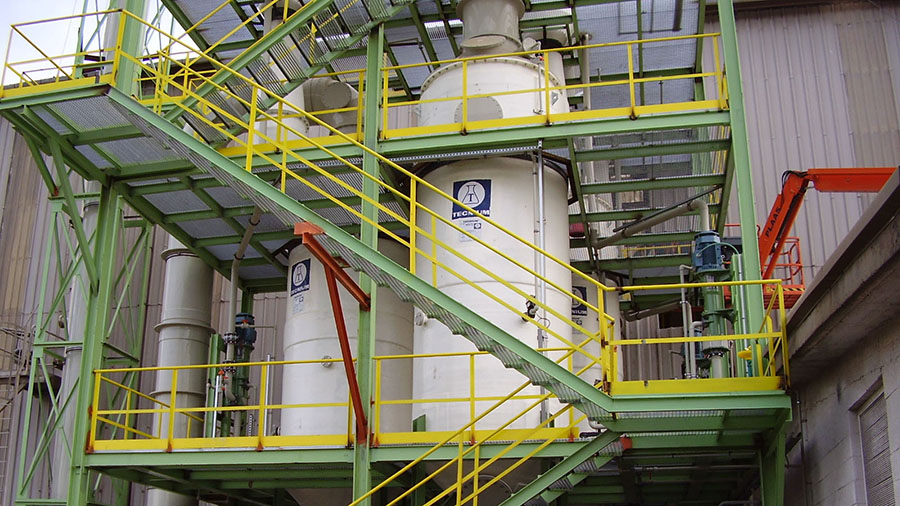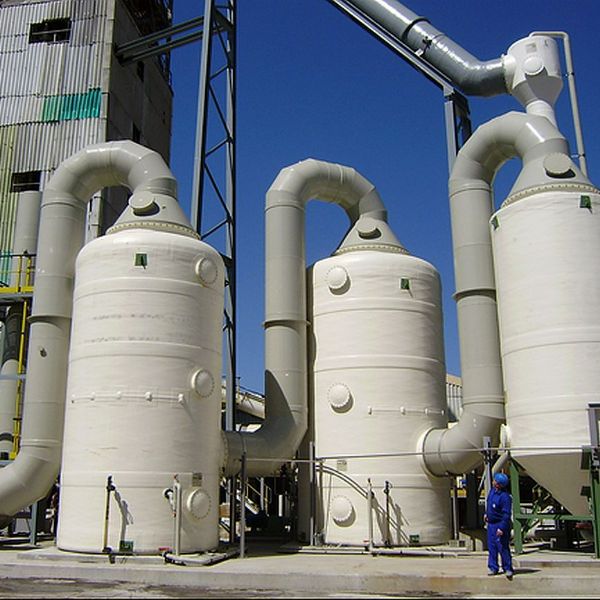The fertilizer industry, vital for ensuring large-scale agricultural production, is also accountable for certain gaseous emissions. If not appropriately addressed, these can be harmful to the environment and human health.
Gas dedusting stands out as one of the most effective solutions to control and mitigate these emissions. In this piece, we’ll delve into the application of this process within fertilizer treatment plants.
Why is dedusting gas treatment?
Dedusting in gas treatment is the process of removing dust and solid particulate matter from exhaust gases. This process is crucial for several reasons:

In essence, dedusting in gas treatment is a critical process that ensures environmental protection, compliance with regulations, equipment longevity, product quality, safety, and potential economic benefits.

Gas treatment on superphosphates
Phosphate-based fertilizer production, specifically TSP and SSP, is a meticulous process fundamental to the agricultural industry. This production starts with introducing phosphoric rock into a reactor. After this initial interaction, the resultant material is conveyed on the Kuhlmann belt, continuing the reaction process. The compound then heads to the granulator, culminating in a drying phase.
Throughout these four critical stages, gas emissions occur. The first two stages, in particular, showcase the most intense emission concentrations. These emissions arise from the phosphoric rock’s reaction with acids, typically H2SO4 or H3PO4. The reactions release F-based gases due to the rock’s fluorides. Gases like HF, SiF4, and F2 emerge, along with a significant dust amount and occasional gases like H2S and CH3SH.
Addressing these emissions requires implementing an efficient gas scrubbing system. This solution comprises two distinct phases:

This comprehensive gas scrubbing system ensures cleaner and more efficient superphosphate production, offering a sustainable and cost-effective solution for fertilizer plants.

Gas dedusting in Ammoniacal Fertilizers
The fertilizer industry leans towards creating compounds combining nitrogen, phosphorus, and potassium (N/P/K). These mixtures vary in proportions, contingent on their end-use and diverse manufacturing methods.
Among the range, ammonium phosphate-based fertilizers, like MAP and DAP, stand out. To meet market demands for these products, production plants have been established where phosphate rock undergoes digestion using HNO3, H2SO4, and/or H3PO4, supplemented with NH3 at specific stages.
Gas Emission Management
The primary gas emission sources stem from the reactor and granulator, with NH3, VOCs, and dust being the main contaminants. To manage these emissions, a three-phase strategy is employed: firstly, a venturi-cyclone system to remove dust; next, an acid wash tower to capture NH3; ands lastly, an alkaline process to treat any HF present.
In scenarios with high NH3 concentration in DAP, a recirculation technique with H3PO4 is employed to produce (NH4)3PO4. Upon crystallization, this compound can re-enter the production line as fertilizer.
Gas dedusting in complex fertilizers
Multi-component fertilizers are formulated with two or three of the fundamental elements: nitrogen, phosphorus, and potassium. They can also include additional nutrients and essential micronutrients.
The manufacture of these fertilizers involves a chemical reaction between their different raw materials. Next, the semi-fluid compound, known as slurry, undergoes processes of granulation, drying, classification, and conditioning. The type of nitrogen present in these fertilizers can vary (nitric, ammoniacal, or uric), depending on the raw materials used.
For the creation of NPK-type fertilizers, essentially two different infrastructures are used: plants that operate through the acid blend and those that use the nitro phosphate method.

Gas emission management and purification
The primary gaseous emissions originate in the granulator and dryer, releasing large volumes of dust with NH3 at elevated temperatures. Given this situation, TECNIUM proposes a recovery system that integrates a venturi and subsequently a multiventuri, ensuring high performance without risk of blockages.
This system not only achieves effective purification but also allows for the recovery and reuse of ammonium salts, such as ammonium phosphate, reducing waste and maximizing efficiency.
Our conclusions
Gas scrubbing is more than a technological solution. It’s an emblem of the fertilizer industry’s commitment to environmental sustainability, health, and welfare. By diligently deploying and maintaining these systems, the industry can continue its essential role in global agriculture without compromising environmental health and safety.
If you would like more information about our solutions for the dedusting treatment gases, please do not hesitate to contact our sales department. Filling in the form on this link with your details, we will be pleased to advise you!
